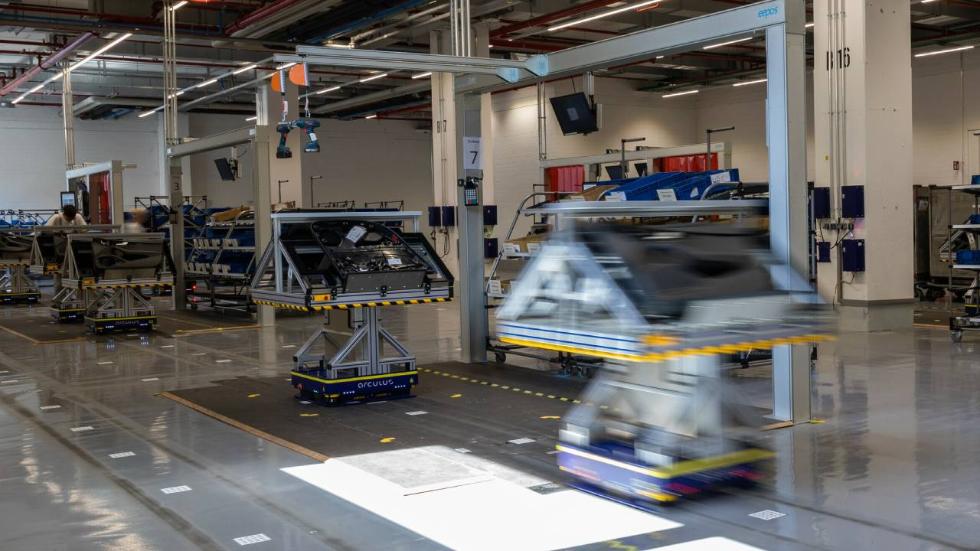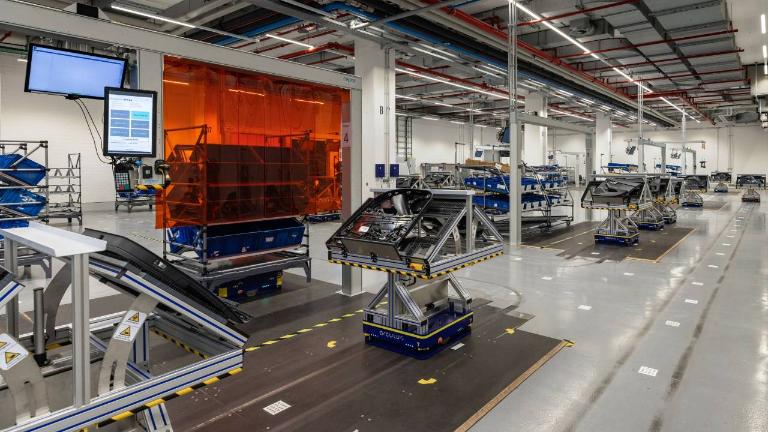Audi, modular assembly for more flexible and efficient production
The flexible system, without conveyor belt and fixed pace, simplifies the management of product variants in production. Productivity increases by about 20% and the work environment is also suitable for employees with disabilities.

In the automotive industry, the conveyor belt has been at the center of production for more than a century, but it is now beginning to show its limitations as processes and components in assembly systems are increasingly variable and the possibilities for customization are growing. Current production involves complexity that is increasingly difficult to master in a rigid, sequential process.
This is why Audi is introducing the first modular assembly system in the automotive industry as a new and supplementary organizational form: technicians assemble components at "production islands" independently of the pace of the assembly cycle, while automated guided vehicles (AGVs) supply the stations with the necessary materials according to the goods-to-person principle.

Dynamic procedures
The conveyor belt based its efficiency on an assembly cycle with a uniform time for each product and at each station in a fixed sequence. Modular assembly, on the other hand, operates without a uniform work rhythm. Instead of a rigid conveyor belt, there are dynamic procedures, with a variable sequence of assembly stations and variant-dependent processing times.
The Audi Production Lab team led by Project Manager Wolfgang Kern is implementing this method in Ingolstadt, in pre-assembly of door panels, and then extending it to series production. "Modular assembly is one of our answers to future demands on production", explains Gerd Walker, Audi Board Member with responsibility for Production and Logistics.
Culture of innovation
"We use digital technology to the benefit of our employees, resulting in a more flexible and efficient assembly. This project is also an excellent example of our open innovation culture, whereby we are developing networked production in agile teams", adds Walker. Looking at the results of the pilot project, experts confirm both the feasibility and potential of modular assembly while creating additional expertise.
One of the main advantages of this system is that it can involve people who, due to their physical limitations, cannot work on the traditional production line instead, "We are able to adapt the working environment to their conditions, which can only be done to a very limited extent with the conveyor belt. In production, we are using more flexible automation to take the burden off people", Kern relates.

Space and time
With this method, tasks no longer follow a uniform sequence, but are structured to meet special needs. Automated guided vehicles (AGVs) bring door panels directly to the station where they are to be assembled. If the various light packages are being assembled at one station, the steps that do not involve lighting are done elsewhere, and meanwhile at another station a technician assembles the sun blinds for the rear doors, which are an optional extra and would have required two or three technicians on the conveyor belt, resulting in a drop in efficiency and quality. But if too much work is piling up at one station, the AGVs deliver the components to the next more free station.

Goods-to-person
The configuration of workspaces is cyclically checked and adjusted. "Compared to the way things are organized today, having flexibility as a basic logic is an essential advancement", Kern resumes. Unlike a conveyor belt, individual stations and the modular production system are not designed for stable demand, but ensure maximum efficiency in variable situations, so the best solution is the goods-to-person principle. Thus the AGVs deliver the necessary wiring for the door panels to the technicians, while the other identical parts go back to the stand-by position, because a different version of the component is usually needed for the next door panel.
This method of using AGVs makes upstream separation redundant, because the vehicles are located to the centimeter via a radio network and guided by a central computer. In addition, inspection can be supplemented with a camera if necessary. In this way, irregularities can be handled more quickly and easily than with a conveyor belt, avoiding unforeseen additional labor. "We are combining the high degree of division of labor of the conveyor belt with a holistic eye toward agile work and the new possibilities offered by cyber-physical production systems", Kern explains.
Increasing productivity
This project is producing valuable information and enabling engineers to derive other applications. "Reducing production time with an orientation toward value creation and self-management allows us to increase productivity by 20%", Kern explains. The next step will be to integrate modular assembly at a larger scale into pre-assembly, because this is where the greatest variability is found, along with dynamics that can be managed more efficiently. "De-linking the stations allows things to be rescheduled without too much effort", Kern concludes. Thanks to the flexible hardware and automated guided vehicles used to transport components, often only the software needs to be adjusted, as stations can be adapted to products and demands more easily than a conveyor belt.
Source: AUDI AG
VGI | U.O. Responsabile: VP | Data di creazione: data dell’articolo | Classe 9.1
